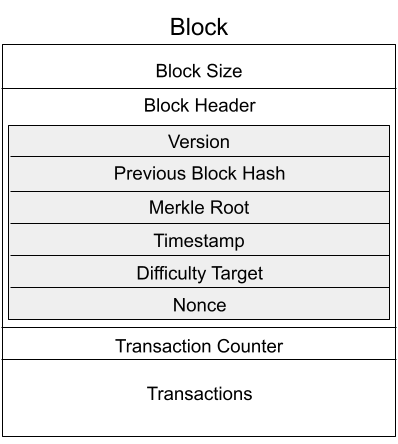16.3. Blocks & Nodes¶
16.3.1. What makes up a Block?¶
A blockchain is simply a linked list of blocks, where each link of the linked list has an associated hash code. We have already seen how these hash codes provide a mechanism to protect the blockchain from being modified without it becoming obvious that this happened. How let’s talk about what might be found in one of the blocks on a blockchain in a typical application.
The figure below provides a visual breakdown of the major components that might be found a given block. No given application is likely to use all of these. A brief summary of each item is included beneath the diagram.
Block Size: The size (stored in bytes) of the given block.
Block Header: An internal object of a block containing relevant metadata.
Version: Describes the version / protocol edition.
Previous Block Hash: The root hash of the previous block.
Merkle Root: The hash of the root node of merkle tree (see Merkle Trees).
Timestamp: The timestamp of block’s creation.
Difficulty Target: Numeric representation of difficulty when block was mined.
Nonce: Cryptographic key used to generate accurate hash.
Transaction Counter: Number of transactions in block.
Transactions: Collection of individual transactions.
16.3.2. Full vs. Thin Blocks and a Community of Nodes¶
Why use a Blockchain? We have already seen that one of the primary distinctions of a Blockchain is that, if any contents are altered, then this can be verified by anyone who knows the initial hashpointer value, and can see the contents of the blockchain. Which begs the question: Why would you be worried that the contents might be altered?
Blockchains are most typically used in the context of a Public Ledger. This is an application that exposes the entire blockchain publicly. In some such applications, only a central, trusted authority can change the contents of the Blockchain, and tampering is not a concern. In other applications (such as cryptocurrencies), many parties are allowed to change the ledger, but there is not much trust involved. This is difficult to get right, and is the domain of Consensus Algorithms. For now, just accept that there is away to handle these updates, but the public parties involved might or might not want to be able to verify that the Blockchain is self-consistent.
There is another practical constraint involved: Some Blockchains are really, really big. For example, the public ledger for BitCoin (including its transaction history) by 2020 had become hundreds of gigabytes in size. This means both that it is expensive to store (space), expensive to search (time), and expensive to verify its consistency (time again).
Fortunately, a Blockchain application of significant size is likely to also attract a signifcant community to it. Operating a large, decentralized blockchain requires coordination among multiple members of the community. These members are sometimes referred to as “nodes” in a network.
A full node contains the entire blockchain and it’s contents. This includes a complete record of every block, including all transactions stored within each block, which as we mentioned is hundreds of gigabytes of data in the case of Bitcoin. A full node has the ability to inspect the validity of the consistency of the blockchain, and therefore can also assess the validity of new blocks proposed to be appended to the blockchain. This is an important safeguard to the community, but not one that every participant feels the need to do for themselves.
Many participants in the community will host a thin node which only stores the metadata needed for each block. This includes the hash pointer for each block, and other descriptive data (time when it was added to the blockchain, etc) that the holder feels necessary for their needs. They might also hold copies of transactions that they are particularly interested in, along with enough information to verify that they are really a part of the blockchain (we discuss this further in connection with Simplified Payment Verification). The purpose of Thin Nodes is to allow the blockchain network to scale more easily than if each node were required to be a full node. A BitCoin Wallet is an example of a thin node. Thin nodes can rely on full nodes to provide them with transaction verification when needed.
The third type of node is one that might, depending on the details of the consensus algorithm used, propose new blocks to add to the blockchain.
There can be additional members of the community that play an important role in the ecosystem. For example, Bitcoin has associated entities known as “block explorers” that organize the transactions into a a searchable database to allow efficient lookup of transactions of interest.



